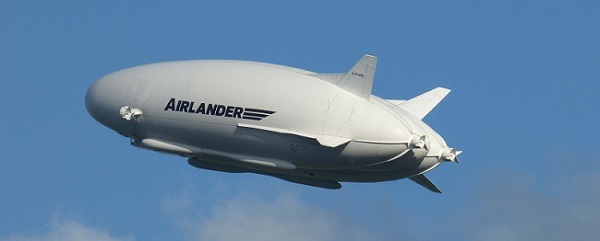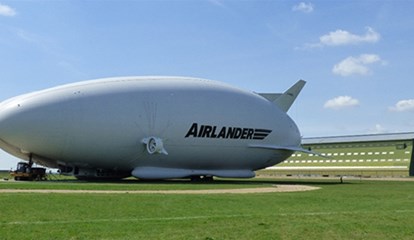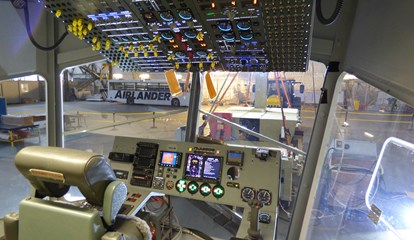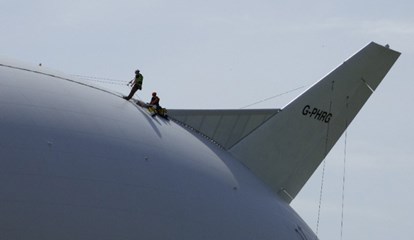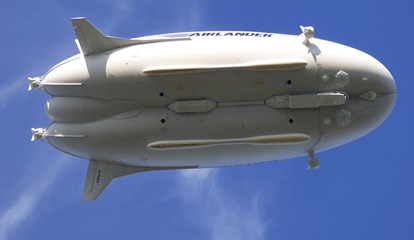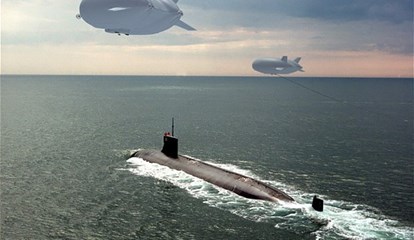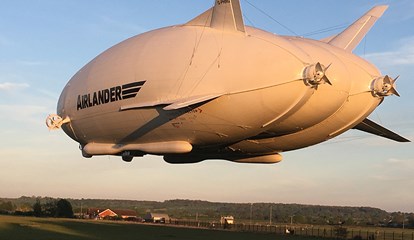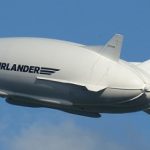 Source: Royal Aeronautical Society – aerosociety.com
Source: Royal Aeronautical Society – aerosociety.com
By Tim Robinson
At a RAeS Flight Test Group Lecture, Hybrid Air Vehicles detailed the flight test progress and next steps in flying one of world’s biggest and most innovative aircraft – the Airlander 10 hybrid airship. Tim Robinson reports.
How do you go about flight testing the world’s biggest aircraft? Speaking at a Royal Aeronautical Society Flight Test Group Lecture on 14 September, Andrew Barber, certification and flight test engineer (FTE), Hybrid Air Vehicles, gave an overview of flight test progress with the Airlander 10 over the past year and a half. He revealed that it had now completed the first phase of EASA approved initial Airworthiness Release trials and HAV received EASA-approval to move onto the second phase, which will see longer, higher flights and more crew carried. He also revealed that the “frequency of the flights should start accelerating” as HAV open up the flight envelope. This next phase is imminent and will take place “before the end of the year”.
First flying on 17 August 2016, to date, the Airlander 10 has undertaken five flights, with the test program interrupted by ‘that’ crash (or more accurately a hard landing) on the second test flight which saw the Airlander receive light damage to the flight deck and cabin. “We did slightly bend the ship” admits Barber. The incident, with no injuries at all, resulted in an investigation by correspondence by the UK AAIB. It also saw organizational, training, CRM changes along with enhanced risk identification at HAV as well as technical changes to the vehicle.
Repaired and upgraded (it now has inflatable ‘fangs’ to prevent cabin damage in the future, along with other improvements such as mooring line retrieval, improved presentation of heaviness, CoG and airspeed to the pilot), it returned to flight on 10 May this year with a flight testing nearly three hours and flew two more flights this year, the latest being on 4 July. So far, the total flight time now adds up to 11hours and 30minutes.
The Airlander 10
For those unfamiliar with what now seems to be a regular tourist attraction in Befordshire (Barber jokes that every test flight has caused traffic jams as word spreads that a flight is imminent), HAV’s Airlander is a UK-designed and developed 92m long hybrid non-rigid airship. First flown as an axed US military project in 2012, it was taken to the UK and modified into the Airlander 10 at Cardington, the UK’s spiritual home of airships. Despite its ‘lighter than air’ designation, the Airlander is slightly heavier than air, aiding ground handling. While helium provides buoyancy, Airlander’s aerodynamic shape, says Barber, ‘generates lift’ and is “a lifting body like the Space Shuttle.” Equipped with four-ducted fan engines (two at the pivot for thrust vectoring), fly-by-light controls and inflatable ‘skids’ the result is an air vehicle with unique properties – slow (almost) silent flight, long endurance (up to five days), 10,000kg of cargo and the ability to land almost anywhere.
“While first flights are without doubt important, this next phase and the opportunity to show the world what it can really offer in term of roles and missions is set to be highly significant for HAV.”
While airships may make some think of 1930s, in reality the Airlander is at the cutting edge of innovation. Its skin and pressure hull draws from the latest in materials science and spacesuit technology, while the fly-by-light control system not only saves weight, but is impervious to lightning strikes.
Airlander is ultra-safe in other ways. Barber notes that presenting the safety system case to EASA was ‘quite difficult’ as there are ‘hardly any catastrophic cases’ that can be imagined for a lighter-than aircraft – almost everything is only ‘hazardous’. Even losing all avionics, he explains would turn it from “an airship into a free balloon, which would then gently drift to earth.”
Handling
Unlike traditional lighter-than-air craft, Airlander in its current configuration handles much like a conventional aircraft, with a short ground roll to take-off and land. Enhanced thrust vectoring in the future will open up full VTOL capability.
On the ground, Airlander is also easier to handle than traditional airships thanks to being slightly heavier than air and vehicles such as the tracked mobile mooring mast – which, along with a tail ‘rollerskate’ allows the ship to weathervane into the wind.
It’s all very gentle, all very slow – take-off is made with the front engines vectoring thrust downward at less than 25kts. Touchdown is made with the aim of landing at 75ft per minute descent speed and about one and a half degrees nose up attitude, with the airship then gently settling on its skids. Equipped with control surfaces on the rear vertical and horizontal fins, Airlander is also equipped with thrust vectoring propulsor vanes that give slow-speed control (invented by one of the Cambridge PhDs working for HAV). While the airship has an aircraft-style control stick, this controls yaw rather than roll and the pilot has no rudder pedals. While the rest of the cockpit in conventional (two Garmin PFDs), engine gauges and power levers, two other gauges (showing hull pressure) indicate that this aircraft is somewhat different than others.
In flight, the experience is described as ‘eerily quiet’ according to Chief Test Pilot David Burns, who also enjoys an unparalleled view with floor to ceiling windows. Test flights this year have strayed no further than 10miles away from Cardington, as far as Millbrook in the west, Henlow in the south and Tempsford in the NE. With only test flights taking place on a permit to fly, Airlander does not fly over congested areas such as Bedford to the north.
Flight test data (approximately 4,000 data items) during these excursions is downlinked to around a dozen HAV engineers in the Mobile Command Centre – a converted bus fitted out with mission control equipment. This, with flight test engineers stations (propulsion, structures and electrical) test director and test safety officer, acts as HAV’s ‘NASA Mission Control’ during the test flights.
HAV also use a Flight Simulation Training Device, with touch screen displays, and flight dynamics and system models produced in-house to de-risk flight testing, with take-offs, landings and trimming all rehearsed beforehand.
Slow and steady wins the race
Five flights so far may not sound like much but it is important to remember three things. First, is that HAV is flight testing an entirely new mode of transport – a hybrid airship and are thus breaking new ground in aeronautics. Though today wind-tunnels, CFD modeling and simulations are extremely useful and have a level of fidelity that previous generations of aircraft designers would have been amazed at, they do not tell the whole story – particularly when there are no similar aircraft to learn from. As a result, the team are maintaining a cautious and a progressive approach with safety as a primary consideration. Weather restrictions and the need for very calm conditions for early flights also accounts for the prudent approach.
Second, is that each flight is, by other prototype standards at this very early stage of flight testing, quite long – with the three flights this year lasting around three-hours each. In later flights this will expand to five and then eight hour flights and eventually 48hr marathons, which (bar one-off record flights like Rutan’s Voyager which spent nine days aloft in a round-the world flight) will be unprecedented for manned aviation. In service, flights up up to five days will be possible.
Third – these two factors (a whole new type aircraft and extended test flights) means that each flight is producing data which requires a staggering amount of analysis by HAV’s small team – this data crunching requires ‘weeks’ rather than ‘days’. Flights over this summer have included more handling investigations and trialed new landing techniques, according to HAV’s Barber.
However, other lessons so far have proved encouraging. In particular, HAV have found that thanks to the Airlander’s tough multilayer skin of Vectran weave, Tedlar, Mylar and polyurethane, the airship has proved more weather-resistant than predicted, with fewer visits inside the hangar and most maintenance done outside.
Future test plans
Looking ahead, the upcoming phase of flight tests, AWR 2a, will see the envelope expanded with day VFR flights – with the maximum altitude increased from 4,000ft to 7,000ft, the speed from 40kt to 50kt and the flight time extended to 5 hours, with the Airlander able to roam 75miles from its base. On these flights, four occupants (two pilots/two mission specialists/FTEs) will be carried, up from just the Chief Test Pilot and a FTE on the first five flights. Although the Airlander is capable of single-pilot operations, so far all flights have been flown with two on board – a pilot and FTE.
These flights will also see the Airlander flown not just to assess its qualities as a flying machine, but as a mission platform. Barber revealed that cost-sharing customer trials will see mission equipment added to Airlander for flight testing in roles such as persistent wide-area surveillance and ISR. In comparison with ISR other platforms such as Reaper UAV, HAV point out the Airlander’s massive payload, volume and its electrical power capacity. (Indeed, Barber observed in his lecture that in WW1, WW2 and as recent as 1962, the Royal Navy and then the US Navy used airships for anti-submarine and maritime patrol.) First customer demos say HAV will be for ‘governmental’ customers.
Following on from this, an anticipated second phase (AWR 2b) of customer trials will see the Airlander flown at night under VFR rules, the ceiling raised to 10,000ft with the speed increased to 60kt. Flight time will also be increased with the goal of eight-hour sorties. More mission equipment too, says Barber, will be added for this phase.
Finally, AWR 3 will see ‘record breaking’ flights, with Airlander flying in IMC and FIKI (flight into known icing conditions) to prove the Airlander’s all-weather capabilities. Barber points out that most airships certificated today are VFR only, with the only airships allowed to fly IFR developed by the team at Cardington. It will also see the pilots shut down two of its engines to cruise on the rear two, extending the flight time to 48 hours. Ceiling will be raised to 16,000 feet, while on these flights up to nine occupants will be able to be carried. The third phase of flight testing will also see restrictions on range lifted completely. “We will be doing some very interesting things then” hints Barber.
Indeed, the upcoming phase of longer flights, both day and night, the need for space and a requirement for access for customers, means that HAV is now moving from its home at Cardington to a new location later this year. Currently it shares the airfield with a film company that uses its giant hangar as a sound stage for blockbuster movies such as Star Wars The Force Awakens, Harry Potter and Batman. With movie sets keen on privacy these days, this obviously means extra restrictions on who can visit – and HAV having its own facilities at a new site will enable it to expand and grow in the future, without worrying about the neighbors. Cardington, though the home of lighter-than-air aviation is also fairly cramped – especially when one considers that at some point in the future, HAV may need space to test and fly multiple Airlanders.
Interestingly, Barber also noted the rise of social media and its effects on flight test. The size and location of Airlander means it is carried out in the full glare of the public. HAV, therefore maintains an active social media presence which is useful in engaging, interacting and quickly responding and rebutting false rumors. HAV, he says, is also helping to ‘re-educate the world’ which, perhaps takes aviation for granted, and is therefore unused to a completely new type of air vehicle being tested.
Demonstration flights
These phase of approved flight tests, AWR2a, crucially allows the company to conduct display and demonstration flights, which means that Airlander can fly customer trials. Already, the giant airship has attracted a significant amount of interest from potential customers who were eager to see what it can do and its possibilities. In fact, Chris Daniels, Marketing Manager at HAV, says he sees an ‘unlimited’ market for the passenger Airlander, adding that he could sell “three years worth of production in a hour” today if it was certificated.
Indeed from speaking to HAV, it is clear it has had to manage expectations from perhaps some over enthusiastic individuals who perhaps underappreciated the need for a cautious and phased flight test campaign. Early test flights for government, parapublic and military customers will thus pave the way for more commercial and civil customers.
Opening up Airlander 10 to customer demonstrations (along with potentially an Airlander appearance at the Farnborough air show in summer of 2018), thus could kick start a surge of fresh commercial and military interest in the opportunities that may emerge from of this new type of aircraft. Could that be humanitarian airlift? Cargo delivery to remote regions? Persistent (crewed or uncrewed) ISR platform? Maritime patrol? AEW? Drone mother ship? Carrier onboard deliver? Luxury aerial cruise liner? TV expedition filming platform (HAV is set to announce a potential aerial expedition customer trial at the end of October), Aerial scientific platform? (One recent proposal in a Royal Astronomical Society publication is to use the Airlander 10s (in UAV mode) to study cosmic radiation levels for up to three weeks at a time. Indeed, even at this early stage, Airlander has already contributed to a UK research project, Safepilot Weather Watch, aimed at developing a 3D route and weather planner for manned and unmanned aviation.
While first flights are without doubt important, this next phase and the opportunity to show the world what it can really offer, in term of roles and missions is set to be highly significant for HAV.
Summary
In short, after a setback last year, HAV is on the cusp of opening up the envelope further, with an accelerated flight test program and customer demonstration flights the next major milestone in the project.
Though some may have been impatient to see faster development, it needs to be remembered that HAV, although drawing on some of the world’s most experienced airship experts and cumulative knowledge, is pioneering a new type of flight here. In this race, it will be slow and steady progress that eventually succeeds.
Source: Royal Aeronautical Society – aerosociety.com

